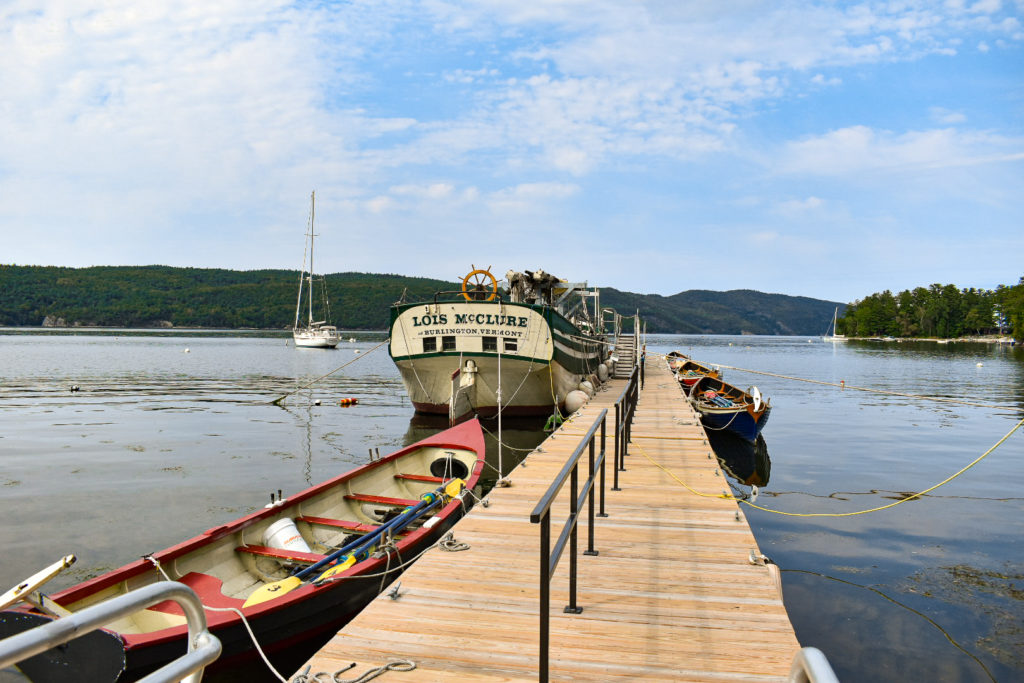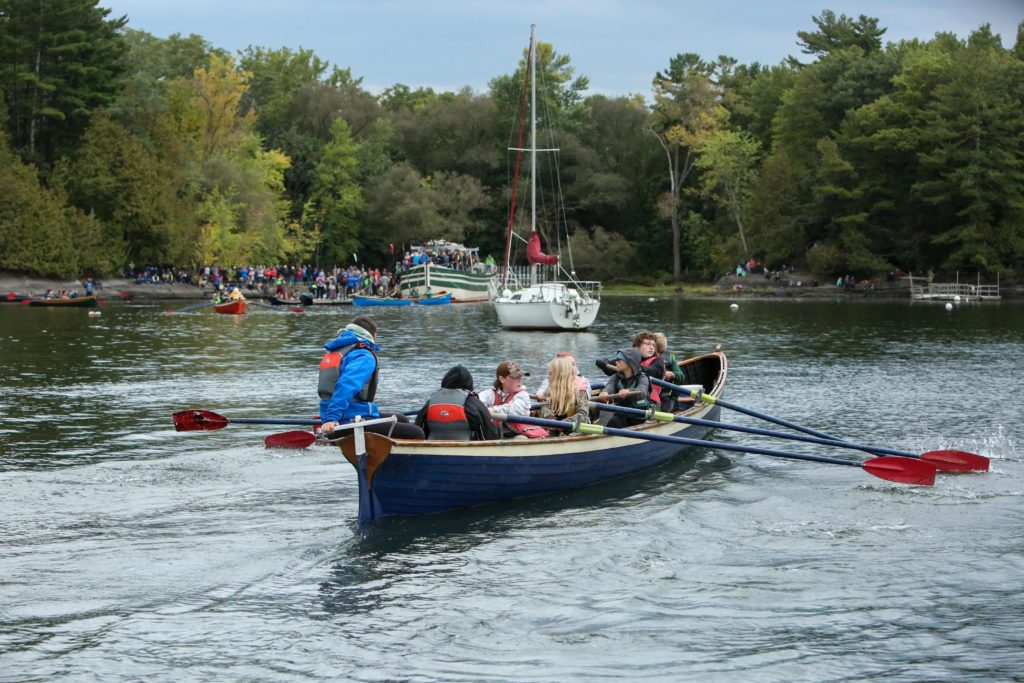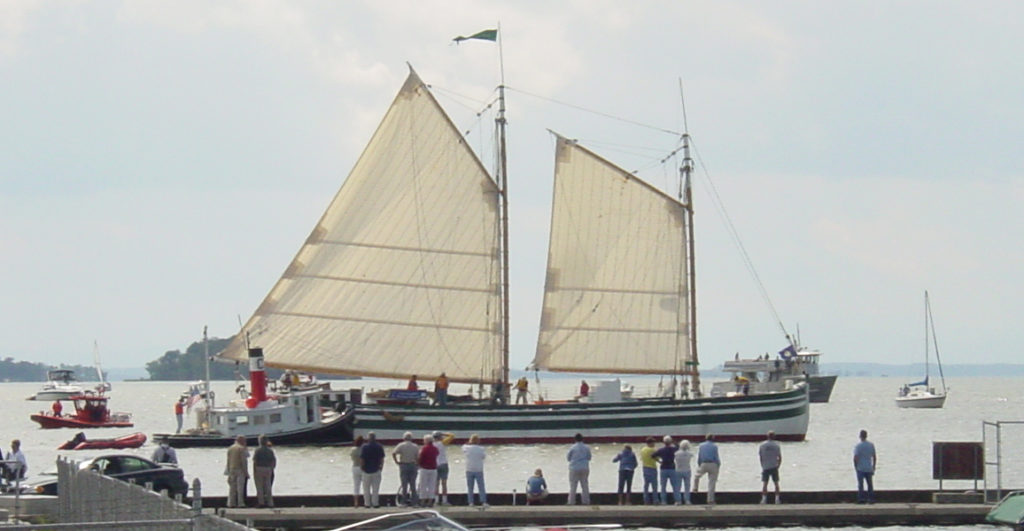Your Biggest Questions About the Schooner Lois McClure, Answered
We noticed that there are some recurring questions about our recent announcement that the replica canal schooner Lois McClure will be retired at the end of 2023. We want to answer them! Today we’re sharing our process of how we came to this decision and answering some of the most common questions.
At Lake Champlain Maritime Museum, we believe the history of the land and the lake belongs to the people of Vermont, New York, and Quebec. We are committed to making sure this history is free and accessible for everyone. The schooner Lois McClure is an important part of the Museum and one of the ways we share the history of the 19th century Champlain Valley with all our audiences.
Before we dig into your questions, we want to underline that this has been a long process for our staff and not at all an easy decision. We’ve spent several years working with our staff, board, shipwrights, and peers to explore a lot of future ideas for the Lois McClure, which we’re going to share more about below.
Many voices, feedback, and perspectives have gone into this process. We also recognize that we all are feeling lots of emotions, including sadness to see the end of an era, pride to have created something amazing, and responsibility to manage this boat well. We’ll continue listening and sharing as we all take this next step together.
What is the schooner Lois McClure?
The schooner Lois McClure is one of the Museum’s replica boats built beginning in 2001 as part of the Canal Schooner Project. It was built to be a historically accurate replica of an 1862-class sailing canal schooner, based on two shipwrecks in Lake Champlain, General Butler and O.J. Walker. You can learn more about the history of sailing canal schooners here.
The goal with this project from the start has been to understand our region’s unique sailing canal schooners, how they were operated, what life was like aboard these ships, and their impact on life and commerce. Since its launch in 2004, the vessel has journeyed local waterways as a floating exhibit and emissary of the Museum, docking at local communities where people could climb aboard to learn about the boat and the history of the Champlain Valley.
The Lois has always been free for the public to visit and maintained by a dedicated crew of staff and volunteers.
Wooden boats can always be repaired, why retire the Lois McClure?
Lois McClure is unique because it is both a museum exhibit and a wooden boat. Both boats and exhibits need regular maintenance and keen review not only to remain afloat (figuratively or literally), but to stay up-to-date and accessible to the communities they serve.
Yes, Lois McClure currently needs short-term repairs. And yes, the boat is currently seaworthy. It will be safe, Coast Guard approved, and open to the public for the next two seasons at the museum. However, it would be irresponsible of us as owners to wait for truly compromising decay or damage before addressing the hard question of what to do.
The Lois will always require annual maintenance as well as larger restoration every 5 to 10 years to remain on water, as all large wooden vessels do. While we know the short-term costs to keep the boat on water, the future of maintaining such a vessel is unending and unpredictable. As Marlinspike Magazine said, wooden boats “don’t ‘retire.’ They get sold, they get repossessed, they get abandoned, they get broken up, they sink at their docks…”
As boat builders and historians, we did not want our own replica project to end in any of those ways. And as a museum, we have to assess how the future meets the goal of the project, exhibit, and our mission. We are creating a responsible game plan where there was not one before. We want to take ownership over the uncomfortable subject and create a good ending for a replica boat project in a way that honors the project, what we have learned, and our community.
Retirement for the schooner Lois McClure means only retirement of the boat from its time on water. The project itself and the history of the canals is still very much a part of our story and our Museum and we are now planning for what’s next.

So what is happening to the Lois McClure?
Our replica schooner Lois McClure will be open on water for all to climb aboard and visit at the Museum during this 2022 season, and next year (2023) as well.
After October 2023, our goal is to use Lois McClure as part of an on-land exhibit about the canals and canal boats at the Museum. We will be working with you, our community, to plan exactly what this exhibit includes, and we want you to participate – we’ll be accepting ideas, drawings, and suggestions for all of 2022. You can submit them here. (There is also a multi-year archiving project starting this summer which will be collecting oral histories, memories, and more. Learn more about that here.)
So do you have ideas for how the Lois could be included in an exhibit? How do you turn an 88-foot boat into a new on-land experience? We’ve already tested and eliminated some options based on physical space, feasibility, and the size of the boat – keep reading.
Can the boat be kept fully intact as an on-land exhibit?
Early on, we had this exact idea! This was one of the first options we explored as an alternative to keeping the boat on water.
For those who like details, there were three key questions to answer for this idea:
- Can we lift the boat out of the water and move onto our grounds?
- Is there space for such a display that is also ADA compliant?
- Can we guarantee the upkeep of the boat long-term, just as we would have to in the water?
We reviewed several great mock-ups and ideas to display the boat intact on land, and we sourced multiple estimates for moving and displaying the boat.
None of our mock-ups, ideas, and budgets could satisfy all three questions we required for this option. It’s disappointing, and it was worth fair consideration, but this just won’t work.
Can the Museum sell or donate the boat to a new home?
This was the next question we asked ourselves too. We’ve had conversations with peer organizations in New York, Vermont, and surrounding New England communities. We have not been able to identify a new home for the Lois McClure.
Taking on an 88-foot wooden replica boat is a big decision and we’re grateful to all our friends for their support of Lois McClure, for considering being a new home for the boat, and for ultimately making the best decision for their organization. Long-term care for such a vessel is a significant commitment and not one that can be made lightly by any organization. We’re not going to share the list of organizations contacted because we respect their privacy.
While we are proceeding with our plan to continue the Canal Schooner Project at the Museum in a way that involves the schooner Lois McClure, we will consider any offers or an alternative home for Lois McClure if the opportunity presents itself.
A new home must be able to financially support the Lois McClure, have the space to house it on water or on land, and be committed to continuing its story and history. If you would like to have a conversation or make an offer for the Lois McClure, please contact us at info@lcmm.org.
Why not fundraise to keep the boat on the water?
There is no amount of money that can guarantee any wooden boat can stay on water forever. It’s the beauty and nature of wooden boats. And as we’ve said, it is not enough to look to short-term financial fixes and continue to avoid the uncomfortable question.
The goal of our fundraising at Lake Champlain Maritime Museum is to achieve our mission and vision. In addition to our exhibits and replica boats, we run a boat building and rowing program for thousands of local middle and high school students; we are the managers of the shipwrecks in Lake Champlain; through archaeological exploration we document and preserve the history of the Champlain Valley for our present and future; we welcome students and teachers to engage with our history and the lake; and we hold summer camps and on-water teen expeditions each summer that are pay-what-you-can for all.
Our fundraising priority is to keep all of this work open, vibrant, accessible, and affordable to our public.

Is there an endowment for the Lois McClure?
There is an endowment for the Canal Schooner Project to share the history of the canals and canal boats in our region.
For the past 20 years this endowment has been employed to cover part of the annual maintenance costs of the replica schooner but it does not cover the entire cost and it cannot alone guarantee the future.
As the project evolves into a new exhibit and on-land experience with the Lois McClure, the endowment will continue to support this work, with the blessing of its original donor.
How are you going to take apart the boat?
How we take the boat apart at the end of 2023 will be determined by how we’re going to use it in the exhibit. We certainly will not be scrapping or irresponsibly cutting it up.
Over the next year, our team of historians and educators will develop an interactive exhibit experience with input from the public. We will work with an exhibit designer to create an accessible, engaging experience that continues to tell the story of canalboats for our museum visitors. After we develop the exhibit plan and design, we will work with boat builders and carpenters to determine the best way to re-use pieces of replica ship as part of the new exhibit.
We want to hear from you!
The Canal Schooner Project has always been a public project, and we are committed to continuing to do this work with you, the public. Let us know your ideas for our future exhibit, share your memories of visiting the Lois, and stay in touch to hear more from us as plans develop over the next few years. We are honored to be sharing our local history with you.



This is a well written document in the past. present and future of this great boat.
Congratulations on all the research you have done to arrive at a very difficult decision.
The staff and Board of Directors deserve much credit and thanks for all you have done for. the LCMM and the Lois McClure.
Ned Pike